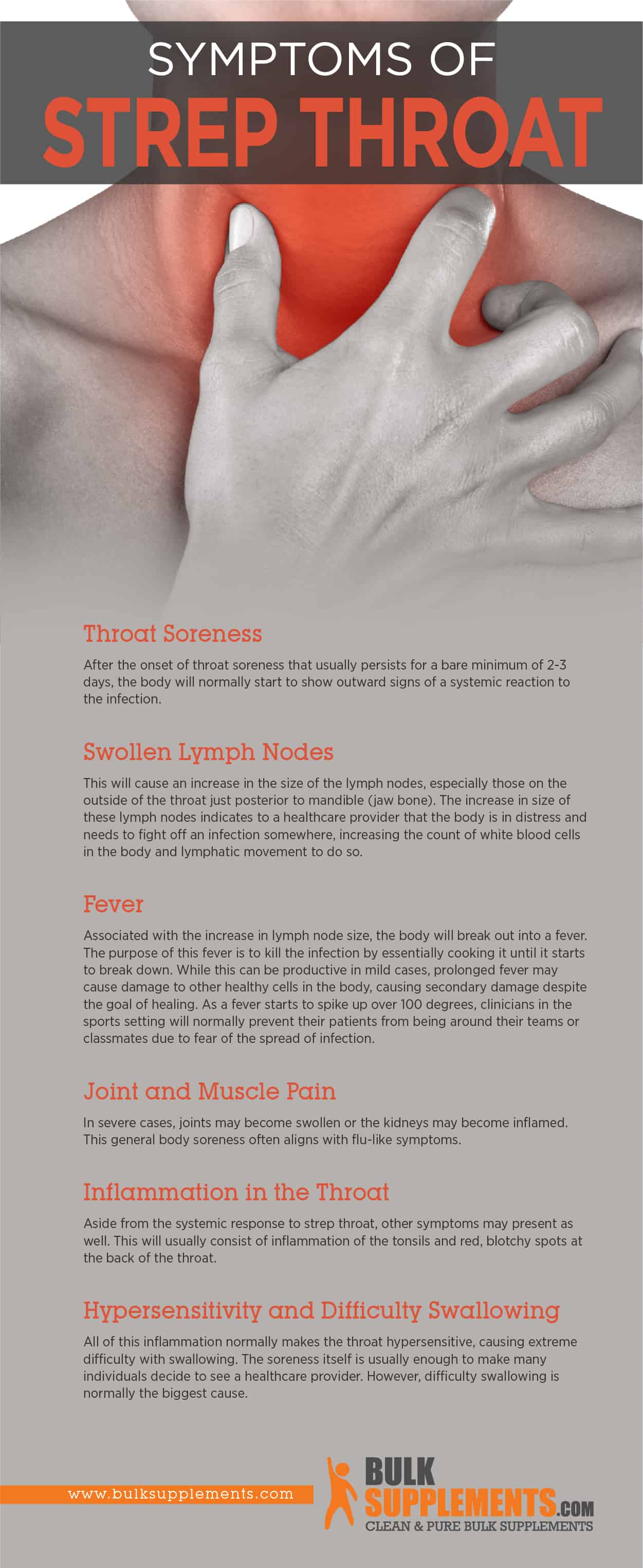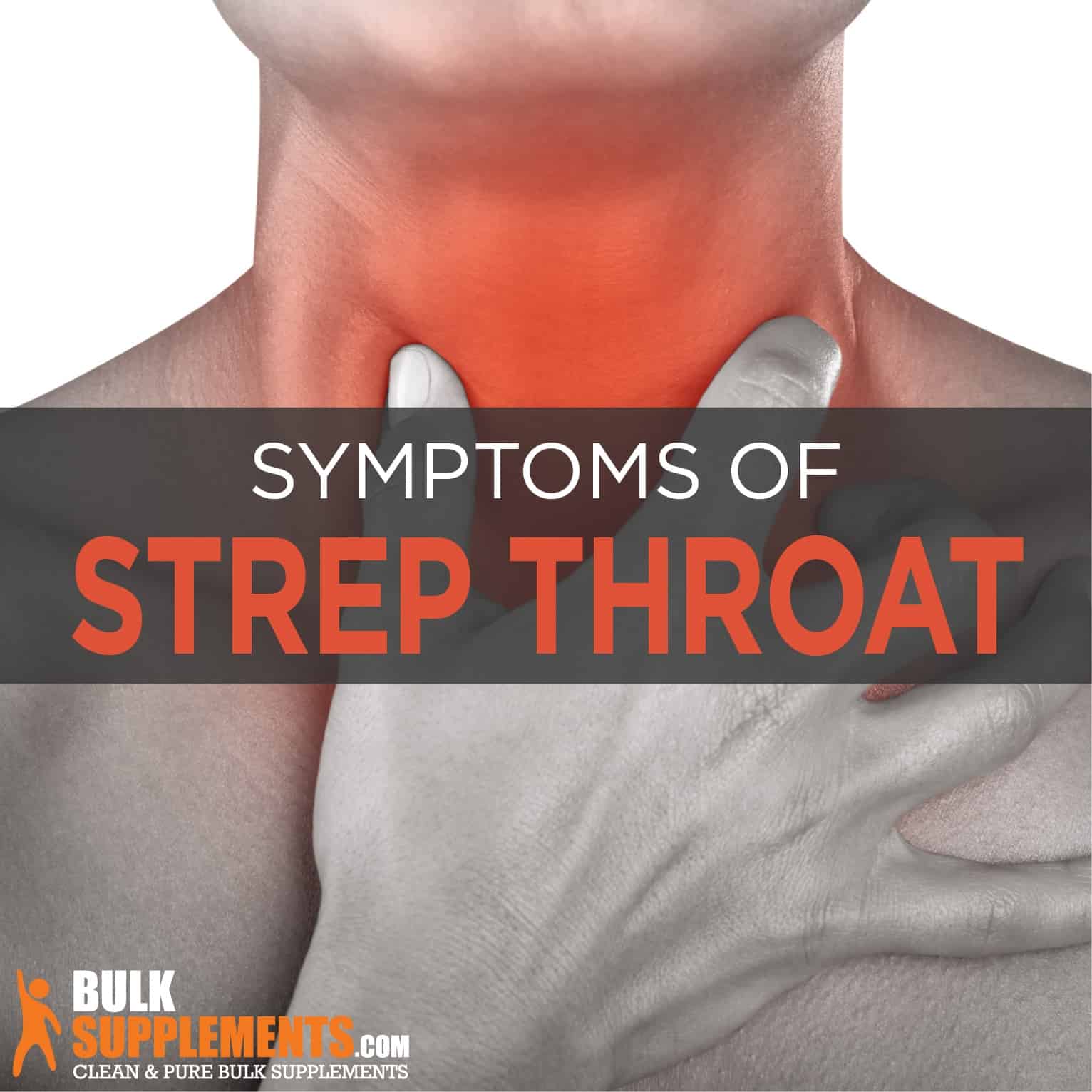What is Strep Throat?
Strep throat is a condition caused by a bacterial infection that causes swelling, itching and soreness at the back of the throat. The reason for its high prevalence among children and adolescents is the close proximity this population has with one another, as well as the extremely contagious nature of the bacteria itself (x).
Commonly, the onset of strep throat is marked by a combination of difficulty swallowing and a sensation of scratchiness. When a child starts to show these two symptoms together, parents commonly assume that strep is the cause. However, strep throat actually makes up a vast minority of sore throat cases. In fact, the two should be distinguished as separate when possible (x).
Often times, strep throat is the product of an associated pathology, displaying itself as a symptom of a viral infection, bacterial infection, inflammatory response, allergen response or many other explanations. The swelling and discomfort of the throat is an outward symptom that should be differentiated from strep, which is a pathology of bacterial nature that directly affects the throat itself, rather than being secondary to the problem itself (x).
Strep Throat Symptoms
There are a number of symptoms that are commonly associated with strep. Namely, these symptoms are sore throat or itchiness/scratching. However, these are not the only symptoms normally experienced as other parts of the body may even be affected depending on how severe the infection has become (x).
Throat Soreness
After the onset of throat soreness that usually persists for a bare minimum of 2-3 days, the body will normally start to show outward signs of a systemic reaction to the infection.
Swollen Lymph Nodes
This will cause an increase in the size of the lymph nodes, especially those on the outside of the throat just posterior to mandible (jaw bone). The increase in size of these lymph nodes indicates to a healthcare provider that the body is in distress and needs to fight off an infection somewhere, increasing the count of white blood cells in the body and lymphatic movement to do so (x).
Fever
Associated with the increase in lymph node size, the body will break out into a fever. The purpose of this fever is to kill the infection by essentially cooking it until it starts to break down. While this can be productive in mild cases, prolonged fever may cause damage to other healthy cells in the body, causing secondary damage despite the goal of healing. As a fever starts to spike up over 100 degrees, clinicians in the sports setting will normally prevent their patients from being around their teams or classmates due to fear of the spread of infection (x).
Joint and Muscle Pain
In severe cases, joints may become swollen or the kidneys may become inflamed. This general body soreness often aligns with flu-like symptoms (x).
Inflammation in the Throat
Aside from the systemic response to strep throat, other symptoms may present as well. This will usually consist of inflammation of the tonsils and red, blotchy spots at the back of the throat.
Hypersensitivity and Difficulty Swallowing
All of this inflammation normally makes the throat hypersensitive, causing extreme difficulty with swallowing. The soreness itself is usually enough to make many individuals decide to see a healthcare provider. However, difficulty swallowing is normally the biggest cause (x).

Strep Throat vs. Sore Throat
The best way to differentiate between strep throat and a sore throat usually involves undergoing a number of tests and an in-depth evaluation from a healthcare provider. Often, coming up with an accurate and clear differential diagnosis will involve assessing symptoms, signs (such as temperature) and performing a throat swab. While it is widely considered to be an unpleasant, though brief experience, the throat swab in conjunction with laboratory analysis has the ability to accurately convey whether or not strep is the culprit (x).
When to Call the Doctor
Many individuals have displayed somewhat of a disregard for discomfort, as they believe seeing a provider over such an issue would cause more of a hassle and not be worth the time, effort or energy. However, once symptoms start to impact daily life and pleasures such as eating and drinking, many will elect to try and find immediate relief to deal with their symptoms. Unfortunately, by this point symptoms have usually progressed to the point where it will take a number of days to have any real impact on the pathology, causing prolonged discomfort and weight loss/dehydration to a point that may become pathological to a tertiary degree (x).
If experiencing any of these symptoms, especially in the winter and spring months, attempting to get ahead of the infection and symptoms is the best way to ensure that quality of life is not impacted to too great of an extent and that the disease does not cause other medical complications. Trying some home remedies may help alleviate symptoms early on, but having a clear medical diagnosis is always in the best interest of the patient as well as for those that they have come in contact with. This is especially true for those who are in school, play team sports or have sexual partners (x).
Causes of Strep Throat
Bacterial Infection
Strep throat is caused by a strain of bacteria known as Streptococcus pyogenes. This type of bacteria is highly contagious and can spread from one individual to another through bodily contact, through the air or by sharing beverages or food. As bacteria normally flourish in their ability to reproduce and spread quickly among those who are in a close proximity to one another, youth is an especially high risk factor. This can range from elementary school all the way through college and also among sports teams (x).
High Risk Times of Year
The infection has the highest rate of incidence during the winter and spring months, aligning up well with flu season. As this is the case, it is important to have a medical diagnosis that can differentiate between the two and thus direct treatment towards a more accurate and effective means (x).
Interpersonal Contact and Sharing
It is best to follow healthy sanitary habits to avoid infection of strep throat. This includes not sharing food or drink, washing hands regularly and disinfecting surfaces that many people will come in contact with (such as treatment tables in a sports medicine setting) (x).
Strep Throat Remedies
When it comes to treatment, there are a number of different medications that are used. In less extreme cases, strep will run its course and give way naturally. However, it can cause secondary issues such as weight loss and extremely unpleasant symptoms. Medications may often include those aimed at treating the symptoms of the disease. They may also be antibiotics designed to combat the bacterial infection itself. Through the years, a number of home remedies have been developed and tested with varying degrees of success. These remedies similarly act to reduce symptoms and restore quality of living for patients (x).
Vitamin C
Vitamin C has an amazing ability to boost the human immune system. While it can certainly be obtained through diet in foods such as oranges and kale, having a more concentrated dosage during the winter helps to provide extra reinforcement. With boosts to the immune system, the body is better able to fight off the bacteria naturally. This helps prevent antibiotic resistance, as well as bacterial mutation (x).
Take the recommended dosage of vitamin C up to 1,000 mg a day or as directed by a doctor.
Vitamin D
Vitamin D is key in the prevention of infections in the upper respiratory tract. In fact, many studies have shown that children who are deficient in this key vitamin are far more likely to develop pathologies that affect ears, nose and throat (or ENT). For patients with this deficiency, supplementing with vitamin D, especially in the winter and spring months, may help prevent infections such as strep throat and others that affect the upper respiratory system (x).
Elderberry
Elderberry is a natural supplement that may have both antiviral and antibacterial effects. Supplementing with this herbal remedy may help to boost one’s immune system while sequentially fighting off low level acute infections. Incorporating protection for both strep and sore throat is likely to make a significant difference during peak-season (x).
The recommended dosage of elderberry extract powder is between 1,000 and 3,000 mg a day.
Coconut Oil
Coconut oil may help stop the spread and proliferation of the Streptococcus bacteria in saliva. Drinking it may help essentially rinse the bacteria from the back of the throat. While this may not be a fool-proof cure, it is one way to minimize the spread of the condition. Additionally, this may help prevent complications such as rheumatoid fever and kidney inflammation (x).
Ginger
Ginger is a natural anti-inflammatory that has many benefits. It may be effective in improving and minimizing the symptoms associated with strep throat; especially swelling of the throat and the tonsils. When supplemented regularly, this is a great natural anti-inflammatory that has added combative potential in a pathological state (x).
Taking ginger root extract as a supplement can provide numerous benefits. Take up to 1,000 mg or ½ tsp with a large glass of water to avoid heart burn.
The Bottom Line
Strep throat is a bacterial infection that is caused by an easily spread strain of bacteria. It can affect a great number of people — especially children during winter and spring. When symptoms manifest, it is important to seek a medical diagnosis right away. Symptoms are similar to those of the flu, so discussion with a doctor for diagnosis is ideal.
Prevention is based around sanitary habits and living a healthy lifestyle that promotes immune system resilience and the necessary vitamins to protect one’s body. If you have any questions about safety and recommendations, consult with your physician prior to beginning supplementation.


